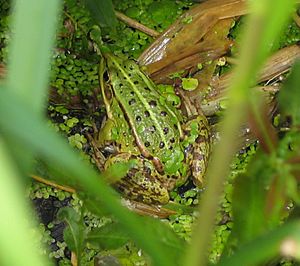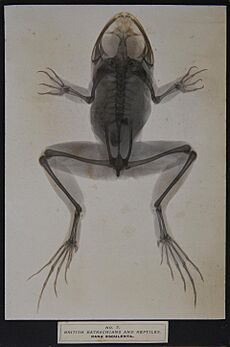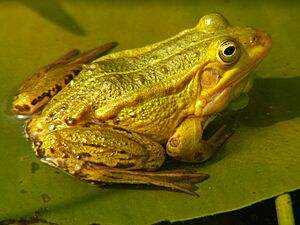Pool frog facts for kids
Quick facts for kids Pool frog |
|
|---|---|
 |
|
| Conservation status | |
| Scientific classification | |
| Genus: |
Pelophylax
|
| Species: |
lessonae
|
| Synonyms | |
|
Rana lessonae Camerano, 1882 |
|
The pool frog (Pelophylax lessonae) is a small frog found in Europe. It belongs to the Ranidae family, also known as 'true frogs'. Its scientific name was given by an Italian scientist named Lorenzo Camerano in 1882. He chose the name to honor his teacher, Michele Lessona.
Contents
What Does a Pool Frog Look Like?
Pool frogs are small. They usually grow to about 8 cm long. Female frogs can be a bit bigger, up to 9 cm. Males are often around 5 cm, and females are about 6 to 6.5 cm.
These frogs can be brown or green. They have dark spots on their backs. You might also see two ridges that go from their eyes down their backs. A cream or yellow stripe often runs down the middle of their back. Male pool frogs have cream or white vocal sacs. These sacs inflate when the male calls.
Where Do Pool Frogs Live?
Pool frogs live across much of central Europe. You can find them from the west coast of northern France to western Russia. There are also smaller groups of pool frogs in the United Kingdom, Spain, Sweden, and Norway.
People once thought that pool frogs in the UK were not native. However, studies now show that English pool frogs are related to those in Sweden and Norway. This means they are likely native to the UK.
Pool frogs like damp places. They prefer areas with lots of plants. You can find them in calm, slow-moving rivers, ponds, bogs, or marshes. They can even live in cities and near fishing areas. When new ponds are built, it helps these frogs spread and grow their numbers.
Pool Frogs in Britain
The pool frog is one of only four amphibian species in the UK that the government protects. Their numbers have dropped for a few reasons. One reason is that their pond homes are shrinking. This happens because of human encroachment, meaning people build more things where ponds used to be. Another reason is air pollution. This pollution can make pond water too rich in nutrients, which harms the frogs.
For a long time, people did not think pool frogs were native to Britain. This was partly because some frogs were brought in from southern Europe. But research now shows that the UK pool frogs are closely related to Scandinavian frogs. This suggests they are indeed native to Britain.
The Herpetological Conservation Trust says that pool frogs were once found in two places in East Anglia. They disappeared from one site in the mid-1800s. By 1995, they were thought to be gone from the wild at the last site. One frog from this group lived in captivity until 1999. Other groups of pool frogs have started living in the UK. Some of these new groups included frogs that were originally from Britain.
A project by English Nature is working to bring pool frogs back. In 2005, they released pool frogs into a site in Breckland.
How Pool Frogs Mix with Other Frogs
The edible frog (Pelophylax kl. esculentus) is a special kind of hybrid frog. It is a mix of the pool frog (Pelophylax lessonae) and the marsh frog (P. ridibundus). These edible frog groups keep going through a process called hybridogenesis. This means they often reproduce by mixing their genes in a unique way with other frog species.




